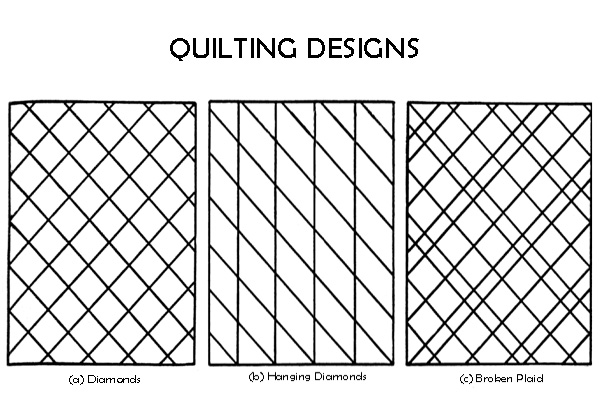Quilting
Quilt Sewing
A knowledge of the simplest form of sewing is all that is necessary to piece quilts. The running stitch used for narrow seams is the first stitch a beginner learns. There are other stitches needed to make a patchwork quilt, which frequently develops into quite an elaborate bit of needlework. The applied designs should always be neatly hemmed to the foundation; some, however, are embroidered and the edges of the designs finished with a buttonhole stitch, and other fancy stitches may be introduced.
In quilt making, as in every other branch of needlework, much experience is required to do good work. It takes much time and practice to acquire accuracy in cutting and arranging all the different pieces. A discriminating eye for harmonizing colours is also a great advantage.
Appreciation of nature is an attribute of many quilt makers, as shown by their efforts to copy various forms of leaf and flower. There are many conventionalized floral patterns on appliqué quilts that give evidence of much ability and originality in their construction. For the pioneer woman there was no convenient school of design, and when she tired of the oft-repeated quilt patterns of her neighbourhood she turned to her garden for suggestions. The striking silhouettes of familiar blossoms seen on many quilts are the direct result of her nature study.
Thousands of quilt blocks and patterns have been created and sewn through the hundreds of years. The history of families sewn into quilts one patch or one stitch at a time, are all part of the legacy included in the art of quilting, passed on from generation to generation.
Did You Know?
"Appliqué work is thought by some to be an inferior kind of embroidery, although it is not. It is not a lower but another kind of needlework in which more is made of the stuff than of the stitching. In appliqué the craft to the needleworker is not carried to its limit, but, on the other hand, it calls for great skill in design. Effective it must be: coarse it may be: vulgar it should not be: trivial it can hardly be: mere prettiness is beyond its scope: but it lends itself to dignity of design and nobility of treatment." The foregoing quotation is from "Art in Needlework" by Louis F. Day and Mary Buckle. It is of interest because it explains how appliqué or "laid-on" needlework ranks with other kinds.
After all the different parts of a quilt top are either pieced or decorated with applied designs, they are joined together with narrow seams upon the wrong side of the quilt. If a border is included in the design it should harmonize in colour and design with the body of the quilt. However, in many quilts, borders seem to be "a thing apart" from the remainder of the top and, apparently, have been added as an afterthought to enlarge the top after the blocks had been joined. In old quilts a border frequently consisted of simple bands of colours similar to those found in the body of the quilt, but more often new material entirely different in colour and quality was added when greater size was desired. Many old quilts were three yards or more square, generous proportions being very essential in the old days of broad four-posters heaped with feather beds.
The top being completed, the back or lining, of the same dimensions as the top, is next made of some light-weight material, usually white cotton. The quilt, to quote the usual expression, is then "ready for the frames."
Traditional Quilting and Beyond...
Quick & Easy Ways to Spruce up Your Home
Improve the look of your house and make it more marketable and appealing. You can redecorate your household interior even if you're on a tight budget. Here are some tips on how to create a brand new look for your home, or simply refresh your existing one, and make everything look neat and... >>> Learn more...



